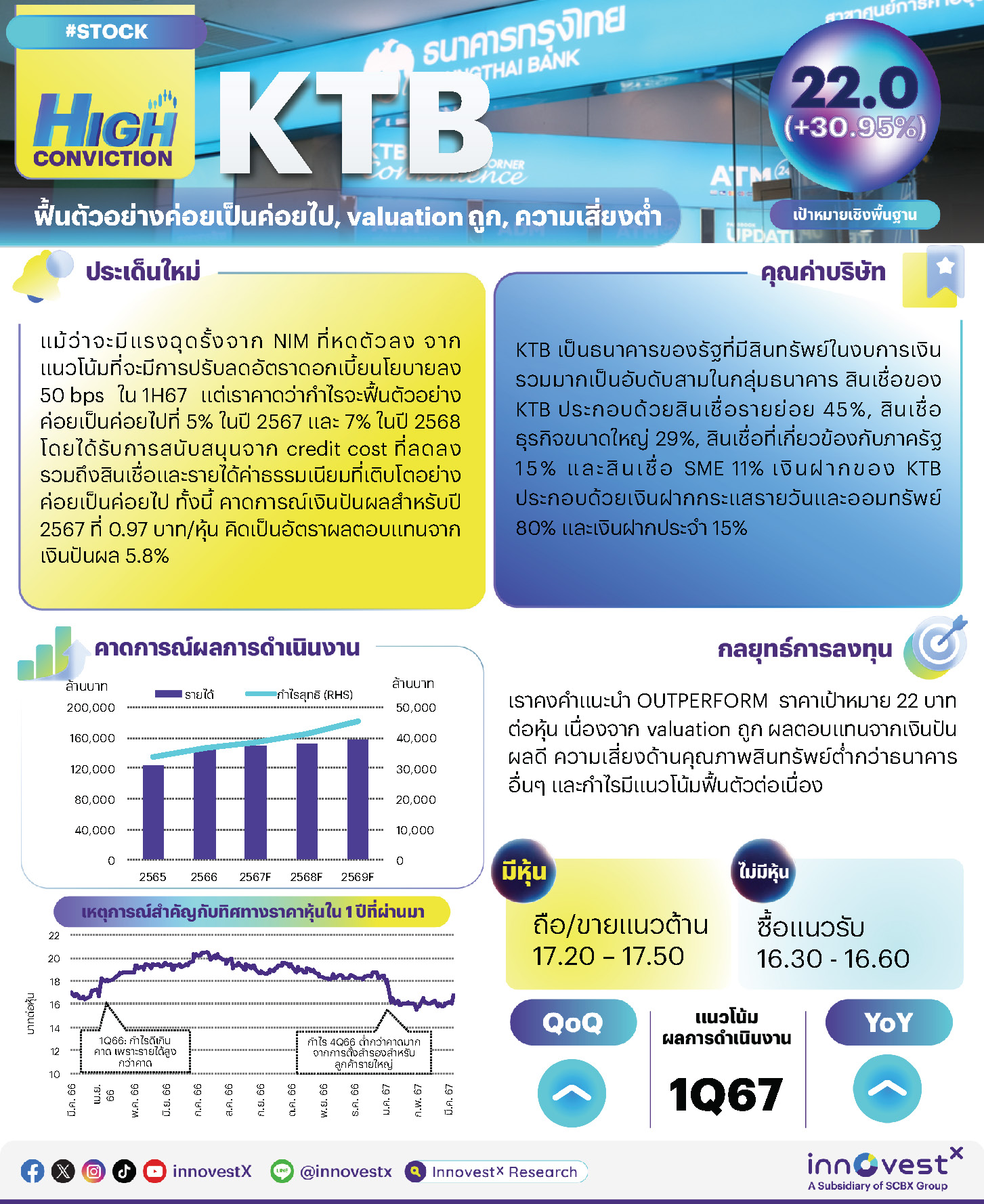High Conviction: KTB – ฟื้นตัวอย่างค่อยเป็นค่อยไป, valuation ถูก, ความเสี่ยงต่ำ – OUTPERFORM (ราคาเป้าหมาย 22 บาท)


ในการประชุมนักวิเคราะห์ KTB ได้เปิดเผยเป้าหมายทางการเงินปี 2567 ซึ่งสะท้อนถึงสินเชื่อและรายได้ค่าธรรมเนียมที่เติบโตอย่างค่อยเป็นค่อยไป พร้อมกับ credit cost ที่ลดลง เรายังคงคำแนะนำ OUTPERFORM สำหรับ KTB และคงราคาเป้าหมายไว้ที่ 22 บาท เนื่องจาก: 1) valuation ถูก และให้ผลตอบแทนจากเงินปันผลดี 2) ความเสี่ยงด้านคุณภาพสินทรัพย์ต่ำกว่าธนาคารอื่นๆ และ 3) กำไรมีแนวโน้มฟื้นตัวอย่างต่อเนื่อง หลักๆ เกิดจาก credit cost ที่ลดลง ปัจจัยกระตุ้น Credit cost ลดลง KTB ตั้งเป้าลด credit cost ลงจาก 1.43% ในปี 2566 สู่ 1.2-1.3% ในปี 2567 และคงอัตราส่วน NPL ไว้ที่ <3.25% เทียบกับ 3.1% ณ สิ้นปี 2566 (ตามการคำนวณของ KTB) โดยใน 4Q66 KTB ได้ตั้งสำรองสำหรับสินเชื่อที่ปล่อยให้กับ ITD (ปัจจุบันจัดเป็นสินเชื่อ stage 2) ไว้ 100% แล้ว หนังสือพิมพ์ประชาชาติธุรกิจระบุว่า KTB ปล่อยกู้ให้กับ ITD จำนวน 4 พันลบ. โดยเป็นเงินกู้ไม่มีหลักประกันจำนวน 2 พันลบ. KTB ตั้งเป้าคง LLR coverage ไว้ที่ >170% เทียบกับ 174% 174% ณ 4Q66 สูงเป็นอันดับสามของกลุ่มธนาคาร เรายังคงประมาณการ credit cost ปี 2567 ของเราไว้ตามหลักความระมัดระวังที่ 1.35% (-8 bps) การเติบโตของสินเชื่อฟื้นตัว, ลดความเสี่ยงในพอร์ตสินเชื่อ KTB ตั้งเป้าการเติบโตของสินเชื่อฟื้นตัวจาก -1% ในปี 2566 สู่ 3% ในปี 2567 ซึ่งสอดคล้องกับประมาณการของเรา ธนาคารตั้งเป้าปรับลดความเสี่ยงในพอร์ตสินเชื่อด้วยการเพิ่มสัดส่วนสินเชื่อธุรกิจขนาดใหญ่และภาครัฐ และสินเชื่อรายย่อย และลดสัดส่วนสินเชื่อ SME ลง ในฐานะธนาคารของรัฐ KTB จึงอยู่ในสถานะที่ดีที่สุดในการคว้าโอกาสปล่อยสินเชื่อภาครัฐ ซึ่งผลตอบแทนที่ปรับด้วยความเสี่ยงอยู่ในระดับใกล้เคียงหรือดีกว่าสินเชื่อธุรกิจขนาดใหญ่บางกลุ่มเล็กน้อย มี upside ระยะยาวจาก virtual bank ในส่วนของการจัดตั้งธนาคารไร้สาขา (virtual bank) นั้น KTB กำลังพูดคุยพันธมิตรที่มีศักยภาพอีกรายนอกเหนือจาก ADVANC และ GULF โดย virtual bank จะไม่ถูกรวมเข้ากับธนาคาร หากประสบความสำเร็จ virtual bank จะสร้าง upside ให้กับ KTB ในระยะยาว โดยผลกระทบจะมีจำกัดในช่วงปีแรกๆ มีแนวโน้มปรับอัตราการจ่ายเงินปันผลเพิ่มขึ้น KTB กำลังพิจารณาปรับอัตราการจ่ายเงินปันผลเพิ่มขึ้นสู่ระดับก่อนเกิด COVID ที่ 35-38% เทียบกับ 33% ในปี 2566 เมื่อใช้สมมติฐานอัตราการจ่ายเงินปันผลที่ 35% เราคาดการณ์เงินปันผลสำหรับปี 2567 ที่ 0.97 บาท/หุ้น คิดเป็นอัตราผลตอบแทนจากเงินปันผล 5.8% กำไรจะฟื้นตัวอย่างค่อยเป็นค่อยไป แม้ว่าจะมีแรงฉุดรั้งจาก NIM แม้ว่าจะมีแรงฉุดรั้งจาก NIM ที่หดตัวลง (ปีละ -4 bps ในปี 2567 และปี 2568) จากแนวโน้มที่จะมีการปรับลดอัตราดอกเบี้ยนโยบายลง 50 bps ใน 1H67 แต่เราคาดว่ากำไรจะฟื้นตัวอย่างค่อยเป็นค่อยไปที่ 5% ในปี 2567 และ 7% ในปี 2568 โดยได้รับการสนับสนุนจาก credit cost ที่ลดลง (-8 bps ในปี 2567 และ -15 bps ในปี 2568) รวมถึงสินเชื่อและรายได้ค่าธรรมเนียมที่เติบโตอย่างค่อยเป็นค่อยไปที่ 3% กลยุทธ์การลงทุนและคำแนะนำ เรายังคงคำแนะนำ OUTPERFORM สำหรับ KTB และคงราคาเป้าหมายไว้ที่ 22 บาท (อ้างอิง PBV 0.7 เท่า ซึ่งอิงกับ ROE ระยะยาวที่ 7%, อัตราการเติบโตระยะยาวที่ 1%, cost of equity ที่ 9.6%) เนื่องจาก: 1) valuation ถูก และให้ผลตอบแทนจากเงินปันผลดี 2) ความเสี่ยงด้านคุณภาพสินทรัพย์ต่ำกว่าธนาคารอื่นๆ 3) กำไรมีแนวโน้มฟื้นตัวต่อเนื่อง ความเสี่ยงที่สำคัญ: 1) ความเสี่ยงด้านคุณภาพสินทรัพย์จากเศรษฐกิจที่ฟื้นตัวไม่ทั่วถึง 2) การเติบโตของสินเชื่อชะลอตัวลงเพราะความต้องการสินเชื่อต่ำและการแข่งขันสูง และ 3) ตลาดทุนผันผวน | |||
ท่านสามารถอ่านและดาวน์โหลดเอกสารได้จาก KTB_HighConviction240325_T
|
Click ดาวน์โหลด Info KTB - 20240325-2